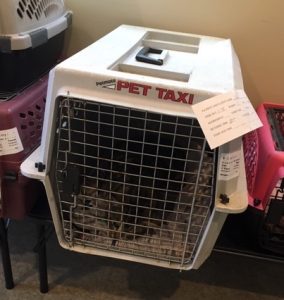We all know that cats are curious, and they can be great escape artists. And if you are the caregiver of a little Houdini, the most important investment you can make in your cat’s life and well being is to have a sturdy, properly working cat carrier.
A lot of folks who don’t have carriers will improvise — with everything from pillow cases to laundry baskets to cardboard boxes — and while it may seem that all’s well if it ends well, transporting a kitty in anything other than a secure carrier can easily end in disaster.
Take, for example, this cardboard cat carrier below — a fine temporary substitute for a carrier, in a pinch — but as you can see from this hole in the side, cats can easily destroy cardboard if they want to find a way out … and that’s just what happened at the clinic recently with a particularly feisty kitty.
As our lead vet tech Sabrina shows below, even a small hole offers plenty of room for a cat to escape, which is why even these temporary carriers aren’t ideal. Fortunately, this cat didn’t go anywhere, but this is why we want to emphasize the importance of safely transporting cats — with SNYP located on Highway 99, a cat who is able to escape any type of homemade or cardboard carrier outside the clinic would be tragic.
See below for an example of what a cat carrier should look like — the carrier should be solid, with working hinges, and absolutely no missing parts (which could cause the carrier to fail). Also, a carrier should be big enough for the cat to stand up and turn around in comfortably (if you have a big kitty, a small dog carrier may work best).
Please also keep in mind that each cat needs his or her own carrier — it’s not only safer, but after surgery, cats can become agitated from anesthesia and can act out toward one another.
Sturdy carriers made of hard plastic are best, unless your cat is incredibly calm, in which case a soft nylon cat carrier can work. Also, a top-loading carrier makes it easier to load a feisty kitty. And when you’re transporting a cat in the car, always be sure someone can hold the carrier — or, you can put it securely on the floor of the car, or use seatbelts to strap it in so the carrier doesn’t move while you’re on the road.







